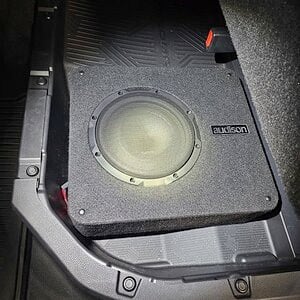skylineTT 10+ year member
bass=sekz
I know some guys come on here asking about ohm loads for their single or multiple speaker setups. Well the way it works is that speakers use voicecoils and each are rated at a certain impedance. Speakers with 1 voicecoil (single voice coil, SVC) have a final ohm load of whatever that coil is rated (single 4 ohm, single 8ohm, single 2 ohm). Speakers with 2 voicecoils (daul voice coil, DVC) are more flexible with a final ohm load because you can parallel and series the coils to achieve lower and higher ohm loads, respectively.
Parallel means that you connect all positive terminals together and all negative terminals together and it decreases the ohm load by a factor of 2 (only on dual voice coil speakers) or by a factor of the number of coils being used (for quad voice coil or multiple speaker setups).
(Example) a dual 4ohm subwoofer in parallel achieves a 2ohm final load.
Series means that you connect a positive terminal to a negative terminal, then connect the remaining positive and negative terminal to the amp. This increases the ohm load by a factor of 2.
(Example) a dual 4ohm subwoofer in series achieves an 8ohm final load.
By series or parallel wiring a speaker, you increase or decrease the final ohm load by the number of coils that are used.
(Example) a quad 1ohm can series 2 pairs of coils to have (2) 2ohm loads. then parallel those 2ohm loads to get a 1ohm final load. Clearly there is more flexibility when you have more coils.
If you don't like thinking about it too hard, you can use these simple online calculators to help you get started.
This calculator shows a few diagrams of different configurations and you can type in the load of each coil to figure out the final load of your setup.
Series Parallel Speaker Impedance
If you use more subs than provided, you might have to calculate it in your head.
.
.
.
This is another simple calculator that lets you apply your amplifiers wattage, then input your speaker's final impedance to calculate power division and final ohm load.
Speaker Impedance
The goal here is to make the "total impedance" value match the impedance value that your amplifier is rated at. Then input the impedance value of your speakers to show how much power each will get. You can select different speaker configurations right above the calculator to better suit your needs as well.
Hope this helps.
This post has been promoted to an article
Parallel means that you connect all positive terminals together and all negative terminals together and it decreases the ohm load by a factor of 2 (only on dual voice coil speakers) or by a factor of the number of coils being used (for quad voice coil or multiple speaker setups).
(Example) a dual 4ohm subwoofer in parallel achieves a 2ohm final load.
Series means that you connect a positive terminal to a negative terminal, then connect the remaining positive and negative terminal to the amp. This increases the ohm load by a factor of 2.
(Example) a dual 4ohm subwoofer in series achieves an 8ohm final load.
By series or parallel wiring a speaker, you increase or decrease the final ohm load by the number of coils that are used.
(Example) a quad 1ohm can series 2 pairs of coils to have (2) 2ohm loads. then parallel those 2ohm loads to get a 1ohm final load. Clearly there is more flexibility when you have more coils.
If you don't like thinking about it too hard, you can use these simple online calculators to help you get started.
This calculator shows a few diagrams of different configurations and you can type in the load of each coil to figure out the final load of your setup.
Series Parallel Speaker Impedance
If you use more subs than provided, you might have to calculate it in your head.
.
.
.
This is another simple calculator that lets you apply your amplifiers wattage, then input your speaker's final impedance to calculate power division and final ohm load.
Speaker Impedance
The goal here is to make the "total impedance" value match the impedance value that your amplifier is rated at. Then input the impedance value of your speakers to show how much power each will get. You can select different speaker configurations right above the calculator to better suit your needs as well.
Hope this helps.
This post has been promoted to an article


